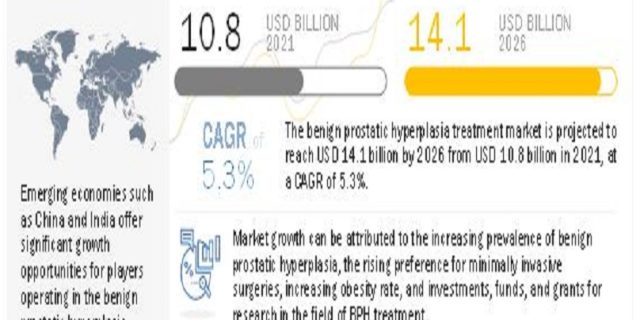
The growth of Benign Prostatic Hyperplasia Treatment Market is driven by the increasing prevalence of benign prostatic hyperplasia, the rising preference for minimally invasive surgeries, increasing obesity rate, and investments, funds, and grants for research in the field of BPH treatment.
The Benign prostatic hyperplasia treatment market is projected to reach USD 14.1 billion by 2026 from USD 10.8 billion in 2021, at a CAGR of 5.3% from 2021 to 2026.
Download PDF Brochure: – https://www.marketsandmarkets.com/pdfdownloadNew.asp?id=198000374
Market Segmentation: –
Based on the type, the BPH treatment market is segmented into drug treatment and surgical treatment. Drug treatment is the largest and the fastest-growing segment in this market. This can primarily be attributed to the use of medications as the first line of treatment among men with mild to moderate symptoms of BPH.
Based on the end user, the market is segmented into home healthcare and hospitals & clinics. In 2019, home healthcare accounted for the largest share of this market, as most patients are prescribed medications over surgery.
Regional Analysis:
On the basis of region, the benign prostatic hyperplasia treatment market is segmented into North America, Europe, Asia Pacific, and the Rest of the World. In 2019, North America commanded the largest share of the benign prostatic hyperplasia treatment market.
Request for Sample Pages: – https://www.marketsandmarkets.com/requestsampleNew.asp?id=198000374
Recent Developments
- In 2021, In January 2021, PHAREX Health Corporation in partnership with the Philippine Urological Association (PUA), launched Pharex Tamsulosin for BPH treatment.
- In 2020, UroLift launched Advanced Tissue Control (ATC) System
- In 2020, Asahi Kasei Pharma obtained Chinese approval for Flivas (naftopidil).
- In 2019, Alembic received approval from the US FDA for its Abbreviated New Drug Application (ANDA) for Silodosin Capsules 4 mg and 8 mg
- In 2018, NxThera’s Rezûm system, a minimally invasive therapy (MIT) for patients with BPH, was included under Boston’s Urology and Pelvic Health business.
Top Key Players: –
The major players operating in this market are Boston Scientific Corporation (US), Coloplast Group (Denmark), Teleflex Incorporated (US), Olympus Corporation (Japan), GlaxoSmithKline PLC (UK), Eli Lilly (US), Pfizer, Inc. (US), Abbott (US), Asahi Kasei Corporation (Japan), Merck & Co., Inc. (US), Astellas Pharma Inc. (Japan), Allergan plc (Ireland), Alembic (India), IPG Photonics Corporation (US), Richard Wolf GmbH (Germany), Unilab, Inc. (Philippines), Pharex Health Corporation (Philippines), Biolitec AG (Austria), Urologix, LLC (US), Advin Health Care (India), Medifocus, Inc. (Canada), Asclepion Laser Technologies GmbH (Germany), Pnn Medical A/S (Denmark), Surgical Lasers Inc. (Canada). Quanta Systems (Italy), Allium Ltd. (Israel), Lumenis Ltd. (Israel), KARL STORZ SE & Co. KG (Germany), and SRS Medical (US).
Conclusion
In conclusion, the global market for BPH treatment is expected to grow in the coming years, driven by the increasing prevalence of BPH among the aging population and the demand for minimally invasive procedures. With the advent of new and innovative treatment options, the BPH treatment market is poised for further growth and development in the future.

